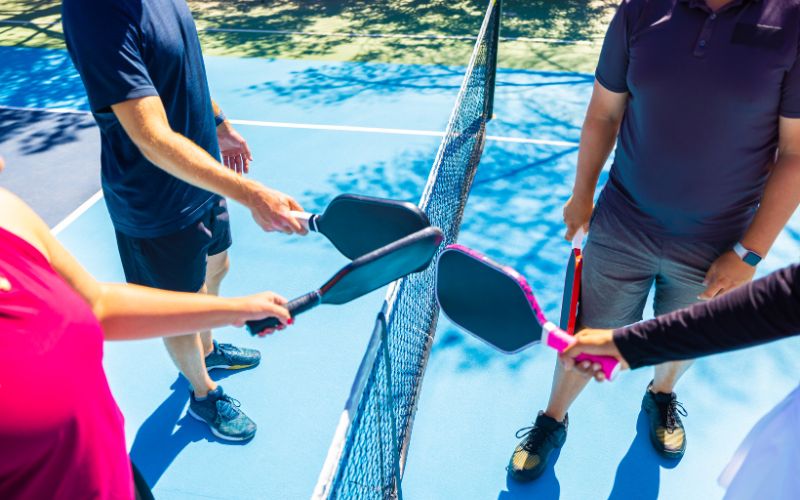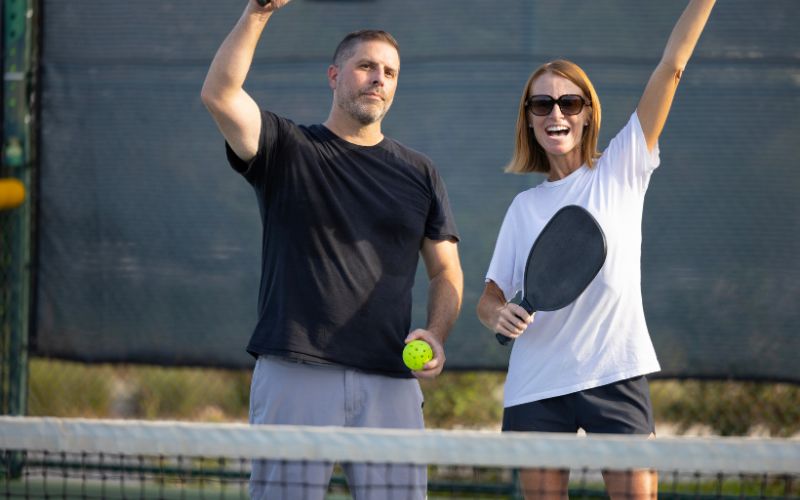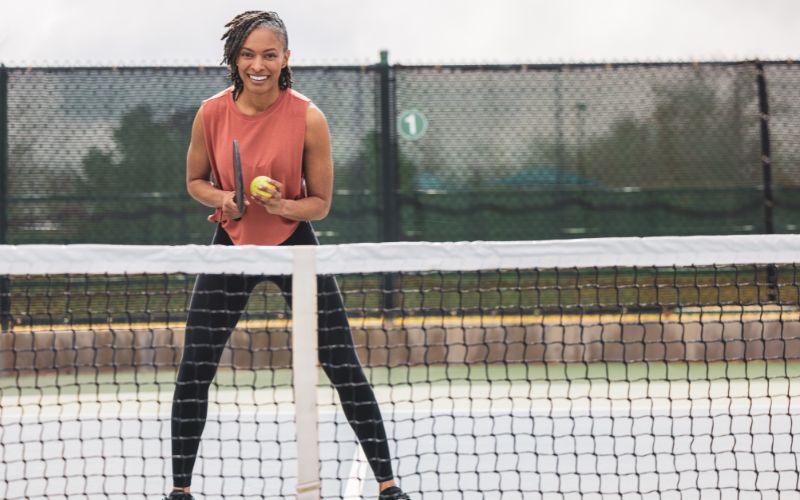Pickleball, once considered a game predominantly for adults, has rapidly gained popularity among kids. This fun and engaging sport, a blend of tennis, badminton, and ping pong, offers a fantastic introduction to racquet sports. Introducing pickleball for kids not only encourages physical activity but also fosters social interaction and skill development.
Understanding Pickleball
Pickleball is played on a pickleball court, typically resembling a smaller version of a tennis court. It involves hitting the ball over a pickleball net using pickleball paddles. The ball used in pickleball is similar to a wiffle ball, which contributes to its unique gameplay.
Pickleball has a fascinating history. It was invented in the 1960s by a few dads who wanted to entertain their families. The game quickly gained traction and has since become one of the fastest-growing sports, especially among different age groups, including kids.
Getting Started: Basics of Playing Pickleball
Rules and Gameplay
Pickleball can be played as a singles game (two players) or a doubles game (four players). The objective is to score points by hitting the ball within the opposing side’s court. Players must adhere to specific rules, including serving, scoring, and the boundaries of the court.
Court and Equipment
A pickleball court is smaller than a tennis court, making it more manageable for kids. The paddles used in pickleball have a smaller grip compared to tennis or ping pong paddles, making them suitable for children to handle comfortably.
Scoring and Winning Points
Scoring in pickleball is straightforward, with games typically played to 11 or 15 points. To win, a team or player must reach the designated point threshold, typically with a two-point lead.
Non-Volley Zone and Strategy
Understanding the non-volley zone is crucial, especially for beginners. This seven-foot area on either side of the net prohibits volleys to maintain fair gameplay.
Rules in Playing Pickleball
Starting the Game: Pickleball starts with a serve. You stand behind the back line and hit the ball diagonally over the net to start the game.
Serving: You serve underhand and hit the ball into the opposite side of the pickleball courts. The ball has to bounce once before the other team hits it.
Volleying and Bouncing: When the ball is served, both teams must let it bounce once on their side before hitting it. After that, you can hit it without letting it bounce (this is called volleying), but only if you’re not too close to the net.
Scoring: You earn points only when your team serves. If you win a rally (when the ball goes back and forth), your team gets a point. Games are usually played to 11 points, but it depends on the rules you’re playing with.
The “No-Volley Zone”: There’s an area close to the net called the “no-volley zone” or “kitchen.” You can’t hit the ball in the air if you’re standing in this zone, except for when the ball has bounced in it.
Double Bounce Rule: After the serve, both teams must let the ball bounce once on each side before volleying. This helps give everyone a chance to hit the ball.
Winning the Game: The first team to reach 11 points (or whichever point number is decided before the game) and is ahead by at least two points wins the game.
Benefits of Pickleball for Kids
Physical Activity and Skill Development
Pickleball offers an excellent sport for kids to engage in physical activity while enhancing their hand-eye coordination and motor skills. The game’s structure and pace allow children to improve their skill level gradually.
Social Interaction and Community
Playing pickleball introduces kids to new friends and a community of players. It’s commonly played in local parks, community centers, and even in makeshift courts at retirement communities, fostering intergenerational interaction.
Family-Friendly Game
Pickleball is a family-oriented game where parents and children can play together, creating opportunities for bonding and shared experiences.
You have the flexibility to play pickleball in various settings.
The official court size measures 20 feet by 44 feet, but if you can’t locate or create a court of that precise measurement, improvisation is possible. Using chalk on a tennis court or devising a makeshift court with string between trees on a flat surface are viable alternatives.
Enjoying pickleball allows for outdoor activity, adding to its appeal.
It accommodates both indoor and outdoor settings, making it an excellent choice for encouraging children to step away from screens and embrace the outdoors. Setting up at a local park on tennis courts offers the opportunity to bask in fresh air while engaging in this exciting sport.
Pickleball presents itself as an additional option in organized sports
Given its surge in popularity, many schools are embracing pickleball tournaments, creating an avenue for kids who might not participate in traditional sports like football or baseball to join a team. For schools without a pickleball program, there’s an opportunity to advocate for its inclusion by rallying other parents or initiating a junior pickleball program within the community.
Playing Pickleball: Tips for Kids
Start Slow and Learn Basics
For kids new to pickleball, it’s essential to start slow and focus on learning the fundamentals. This includes understanding the service area, proper paddle grip, and hitting techniques.
Practice and Persistence
Encourage children to practice regularly to improve their game. Persistence and dedication will gradually enhance their playing skills and confidence on the court.
Playing with Teammates
In doubles games, teamwork is crucial. Encourage communication and coordination with teammates to strategize and play effectively.
Conclusion
Pickleball is an inclusive and enjoyable sport for kids of all ages, offering a blend of physical activity, skill development, and social interaction. With its smaller court size, unique equipment, and straightforward rules, pickleball provides an accessible entry point for children into the world of racquet sports.
Introducing pickleball for kids not only promotes a fun and engaging activity but also cultivates essential life skills such as teamwork, perseverance, and sportsmanship. As the pickleball craze continues to grow, more communities, schools, and families are embracing this exciting game as a means of fostering healthy lifestyles and enjoyable pastimes for children.
FAQs for “Pickleball for Kids: A Fun Introduction to a Growing Sport”
What is pickleball, and how is it suitable for kids?
Pickleball is a racquet sport played on a smaller court, combining elements of tennis, badminton, and ping pong. It’s ideal for kids as it encourages physical activity, social interaction, and skill development in a fun and engaging manner.
How is pickleball played, and what are the key rules for kids to know?
Pickleball can be played as singles or doubles. Players serve underhand, let the ball bounce once on their side after a serve, and observe specific rules, including scoring only when serving, the non-volley zone near the net, and the double bounce rule after the serve.
What are the benefits of pickleball for kids?
Pickleball offers physical activity, enhances hand-eye coordination, and fosters motor skills. It promotes social interaction, introduces kids to a community of players, and serves as a family-friendly game that encourages bonding.
Can pickleball be played in various settings, and what if there’s no official court available?
Yes, pickleball is flexible in terms of settings. While the official court size is 20 feet by 44 feet, improvisation is possible. Chalking a tennis court or creating a makeshift court with string between trees are viable alternatives, making it accessible for children.
How can schools and communities incorporate pickleball for kids?
Many schools are introducing pickleball tournaments, providing an alternative for kids not interested in traditional sports. For schools without a program, parents can advocate for inclusion, possibly initiating a junior pickleball program within the community to further promote the sport.






